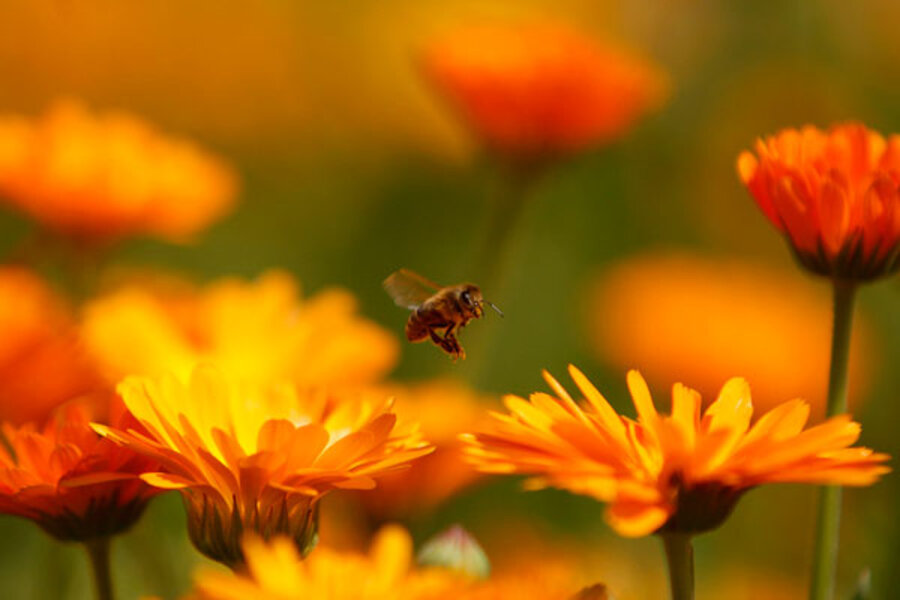Bees use the 'force' to choose the best flowers, study finds
Loading...
If you're a bee having a hard time finding that flower trying to tell you it's loaded with nectar and pollen, use the force, bee, use the force.
For the first time, scientists have demonstrated that the interaction of charges that can build up naturally on bees and plants plays a role in helping the insects find the best flowers to nourish themselves and the hive.
Bees have long been known to use color, shape, patterns, and odor to identify their their floral targets. The new study, conducted by researchers at the University of Bristol in Britain, suggests that bees also use electrical cues. Based on the results, the researchers suggest that if bees approach a flower and sense a disturbance in the "force," they know another bee has beat them to the blossom.
From a bee's perspective, electrical cues are another tool that enables more-efficient foraging. The flower also benefits, according to University of Bristol biologist Daniel Robert, who oversaw the study.
"The last thing a flower wants is to attract a bee and then fail to provide nectar," he said in a prepared statement. Bees quickly learn which flowers are productive and which aren't. The ones that aren't are less likely to get visits and have their pollen spread to other flowers for reproduction. The electrical cues they receive from the flowers may represent a "come back later" signal.
Bees' ability to sense and respond to plants' electrical fields "is a remarkable finding, " says Mark Winston, a biologist at Simon Fraser University in Burnaby, B.C., and the author of a book on bee biology.
It represents another method "by which bees perceive the world around them and it adds another wonderful story that continues to deepen our understanding the co-evolved relationship between bees and flowers," he says.
For 30 years, some researchers have posited that electrostatic charges that can build up on bees play a role in the bees taking up and transporting pollen – a kind of small-scale static cling. They also found that the voltage associated with a flower changes as it's pollinated.
But the experiments by Dr. Robert and colleagues suggest that electricity represents a medium for conveying information between flower and bee before the bee lands.
Previous studies had indicated that bees carry a positive electrical charge with voltages that in some cases can reach as high as 200 volts. They build up the charge as they fly. With their roots in the earth, plants tend to carry a negative charge.
The team's experiments confirmed those earlier results, as well as the effect an arriving bee can have on a plant's electrical traits. Essentially, as the bee approached and landed on the flower, the bee transferred some of its charge to the plant stem, driving the plant's charge positive for up to nearly two minutes. (By contrast, the changes a bee can trigger to a flower's scent, shape, color, or even humidity, last from several minutes to hours, the researchers note.)
Wanting to push further, the researchers conducted a series of tests.
First, they wanted to see to see if bees actually use these electrical changes to help them learn more quickly which flowers to target. To do this, they turned bees loose on identically colored steel disks used as stand-ins for flowers. Some disks carried a liquid bees find distasteful. The others had a nectar-like liquid.
When the scientists added a 30-volt charge to the disk with the nectar, the bees accurately picked out the nectar-bearing flowers 81 percent of the time during the final 10 visits of the 50-visit training session. When there was no electrical difference, the bees did little better than a coin toss in picking out the flowers offering the nectar-like reward.
**Next, the team wanted to see if bees responded to patterns in voltage distribution across a flower. So some faux flowers were given a bull's-eye pattern in which the outer ring received the highest positive voltage, while the center was held at a negative voltage. A single voltage was applied to the other flowers. The bull's-eyes also held the nectar-like reward, while the uniformly-charged flowers got the bitter vetch.
Here, 70 percent of the bees went to the bull's-eye flowers by the end of the training session. When the bull's-eyes were removed and same voltage was applied equally across both the sweet and the sour flowers, a smaller group of bees culled from the larger group couldn't tell the difference at the end of a 50-visit training session until they took a sip. They moved more randomly among the flowers.
Finally, the team conducted a test to see if color and electrical cues worked in concert to aim bees at the nectar-laden flowers. Using color alone, it took 35 visits to the flowers for the bees to hit the 80-percent success mark by the end of the training visits. For bees using color and electrical cues, it took only 24 visits.
Taken together, the team says its results show that electrical fields play a "thus-far under-appreciated role in plant-insect interactions."
Simon Fraser University's Dr. Winston suggests a broader lesson.
"We really underestimate the number and diversity of sensory modes" that humans use to communicate with one another, he says. "One of the great advantages of doing this kind of research with bees is that you can do the kind of experiments and you can measure the kinds of subtle modalities in a fairly simple system compared to people."
"It reminds us that we likely have things going on like this as well that we use and we process, but that we really don't understand and can't really define," he says







